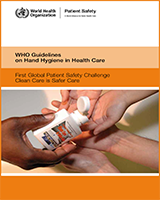All rights reserved. Publications of the World Health Organization can be obtained from WHO Press, World Health Organization, 20 Avenue Appia, 1211 Geneva 27, Switzerland (tel.: +41 22 791 3264; fax: +41 22 791 4857; e-mail: tni.ohw@sredrokoob). Requests for permission to reproduce or translate WHO publications – whether for sale or for noncommercial distribution – should be addressed to WHO Press, at the above address (fax: +41 22 791 4806; e-mail: tni.ohw@snoissimrep).
NCBI Bookshelf. A service of the National Library of Medicine, National Institutes of Health.
WHO Guidelines on Hand Hygiene in Health Care: First Global Patient Safety Challenge Clean Care Is Safer Care. Geneva: World Health Organization; 2009.

WHO Guidelines on Hand Hygiene in Health Care: First Global Patient Safety Challenge Clean Care Is Safer Care.
Show detailsIn 1938, Price63 established that bacteria recovered from the hands could be divided into two categories, namely resident or transient. The resident flora (resident microbiota) consists of microorganisms residing under the superficial cells of the stratum corneum and can also be found on the surface of the skin.64,65 Staphylococcus epidermidis is the dominant species,66 and oxacillin resistance is extraordinarily high, particularly among HCWs.67 Other resident bacteria include S. hominis and other coagulase-negative staphylococci, followed by coryneform bacteria (propionibacteria, corynebacteria, dermobacteria, and micrococci).68 Among fungi, the most common genus of the resident skin flora, when present, is Pityrosporum (Malassezia) spp.69. Resident flora has two main protective functions: microbial antagonism and the competition for nutrients in the ecosystem.70 In general, resident flora is less likely to be associated with infections, but may cause infections in sterile body cavities, the eyes, or on non-intact skin.71
Transient flora (transient microbiota), which colonizes the superficial layers of the skin, is more amenable to removal by routine hand hygiene. Transient microorganisms do not usually multiply on the skin, but they survive and sporadically multiply on skin surface.70 They are often acquired by HCWs during direct contact with patients or contaminated environmental surfaces adjacent to the patient and are the organisms most frequently associated with HCAIs. Some types of contact during routine neonatal care are more frequently associated with higher levels of bacterial contamination of HCWs’ hands: respiratory secretions, nappy/diaper change, and direct skin contact.72,73 The transmissibility of transient flora depends on the species present, the number of microorganisms on the surface, and the skin moisture.74,75 The hands of some HCWs may become persistently colonized by pathogenic flora such as S. aureus, Gram-negative bacilli, or yeast.76
Normal human skin is colonized by bacteria, with total aerobic bacterial counts ranging from more than 1 × 106 colony forming units (CFU)/cm2 on the scalp, 5 × 105 CFUs/cm2 in the axilla, and 4 × 104 CFU/cm2 on the abdomen to 1 × 104 CFU/cm2 on the forearm.77 Total bacterial counts on the hands of HCWs have ranged from 3.9 × 104 to 4.6 × 106 CFU/cm2. 63,78–80 Fingertip contamination ranged from 0 to 300 CFU when sampled by agar contact methods.72 Price and subsequent investigators documented that although the count of transient and resident flora varies considerably among individuals, it is often relatively constant for any given individual.63,81
- Normal bacterial flora on hands - WHO Guidelines on Hand Hygiene in Health CareNormal bacterial flora on hands - WHO Guidelines on Hand Hygiene in Health Care
- MnSOD, partial [Hevea brasiliensis]MnSOD, partial [Hevea brasiliensis]gi|5777414|emb|CAB53458.1|Protein
- USP3 ubiquitin specific peptidase 3 [Homo sapiens]USP3 ubiquitin specific peptidase 3 [Homo sapiens]Gene ID:9960Gene
- 9960[uid] AND (alive[prop]) (1)Gene
- FOSL1 FOS like 1, AP-1 transcription factor subunit [Homo sapiens]FOSL1 FOS like 1, AP-1 transcription factor subunit [Homo sapiens]Gene ID:8061Gene
Your browsing activity is empty.
Activity recording is turned off.
See more...